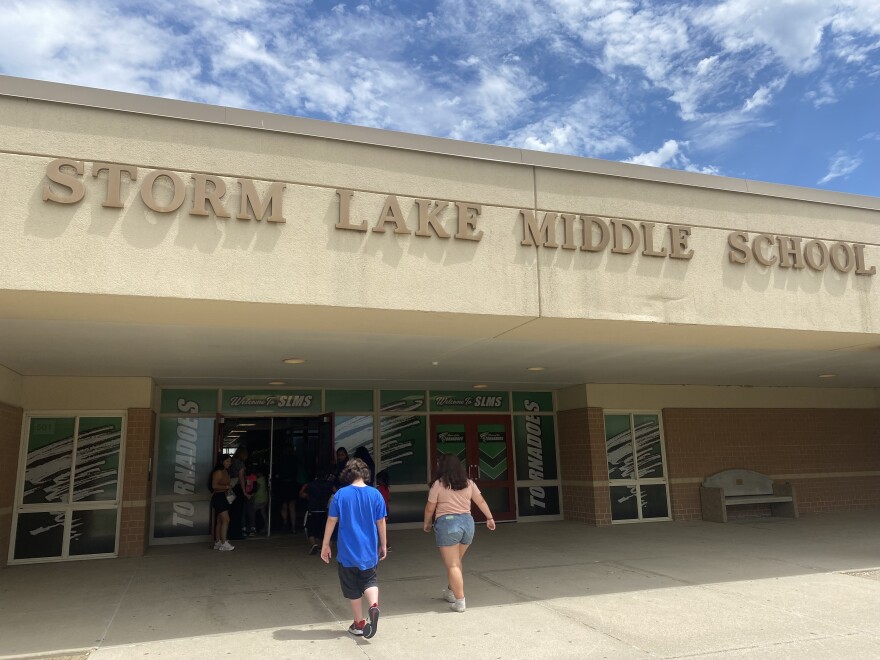State aid for public schools will increase by $107 million to reach a total of about $3.7 billion in the next fiscal year under a budget plan signed by Gov. Kim Reynolds Tuesday. It's an amount Republicans promoted as the largest growth in school funding in nearly a decade, even as Democrats and public school advocates warned that cuts are still likely in some districts, in spite of the increase.
“This results in a $1.19 billion increase in K-12 education funding since 2012,” Reynolds said in a statement. “This investment represents our commitment to an excellent education system for all Iowans.”
House approves public school funding plan
The 3% increase in per-student public school funding is the largest percentage increase since 2015.
The bill also adds $900,000 to transportation aid to schools with higher than average busing costs.
Speaking during House debate on the funding bill Tuesday, Rep. Craig Johnson, R-Independence, said Republicans settled on an amount they believe best fits the state budget.
“Being predictable with what we do here in Iowa is important to us,” Johnson said. “This bill will do that. “And being affordable — we’re going to afford this again this year, and next year and the year after that.”
Democrats failed to advance an amendment that would have provided a 6% school funding increase, which would be $267 million. They said that’s the same amount the GOP is spending on corporate tax cuts and private schools next fiscal year.
Rep. Sue Cahill, D-Marshalltown, said the legislature could have added more funding for public schools if not for Gov. Reynolds’ Students First Act, which directs state money into new education savings accounts that can be spent on private school tuition.
“I feel what we’re giving now are the dregs, the leftovers, what we can absorb in our budget," Cahill said. "Yet our budget was wide open when we voted on the ESA bill. There was no limit. There was no cap on that budget.”
There is no cap on what the state would spend on education savings accounts. The 3% increase in state per-student funding means families who get an ESA next fall will receive $7,635 instead of the original $7,598, which was based on Reynolds’ proposal for a 2.5% increase in state aid.
With this higher increase in per-student funding, the estimated cost for the first year of the ESA program is about $107.5 million, which is close to the increase in state aid for public schools.
Four Republicans joined Democrats to vote against the school funding measure. House Speaker Pat Grassley was asked about their opposition.
“I think that some members feel that they wanted to have more for what they heard back from their local districts, but I think you saw a clear majority of our caucus that felt that 3% was a responsible number,” Grassley said.
Grassley said the increase on top of existing school funding shows Republicans are invested in public education.
“We’re spending $3.7 billion after the passage of this bill now heading to the governor’s desk on supplemental school aid,” Grassley said. “That’s about 45 percent of the state’s budget.”
Iowa Senate advances 3% increase for public schools
Republicans in the Iowa Senate moved first to pass the school funding increase Thursday, approving a 3% increase per-student public school funding that would amount to about $107 million more in base K-12 funding compared to last year.
Senate Majority Leader Jack Whitver, R-Grimes, was asked if Republicans agreed to that amount for public schools to try to match how much new money will go to private schools next fiscal year through education savings accounts.
“We looked at a lot of different things, as we do every year,” Whitver responded. “And, you know, that’s what our budget looks like, what inflation looks like, what is happening at the schools, any new rules we might have put on them. So we looked at everything, but felt like 3% was an amount that is sustainable for the state going forward. And we know that we can fund it.”
Sen. Sarah Trone Garriott, D-West Des Moines, said 71 school districts with declining enrollment will get less money than last year or will have to raise property taxes. She said by voting for a 3% increase Republicans were choosing to give their communities less.
“How many staff positions will need to be cut? Which programs will students lose? How much bigger will class sizes have to get?” she asked. “Because funding is not keeping up with real and rising costs.”
Trone Garriott said districts that lose a handful of students don’t necessarily have declining costs, as that doesn’t change the amount spent on heating the building or fueling school buses.
At a subcommittee hearing Wednesday, lobbyists for public school groups and the statewide teacher’s union said schools need a 4% or 5% increase to at least maintain the status quo and to try to compete for workers.
“When we find ourselves in a situation where the local Casey’s can pay more money than a school district is able to offer for a para-educator, or an aide in a classroom, we know that there is a reduction then in the quality one-on-one time and attention we can deliver to our students,” said Melissa Peterson with the Iowa State Education Association.
This story was updated Wednesday, February 8, 2023 to show that the school funding bill was signed by Gov. Kim Reynolds.





